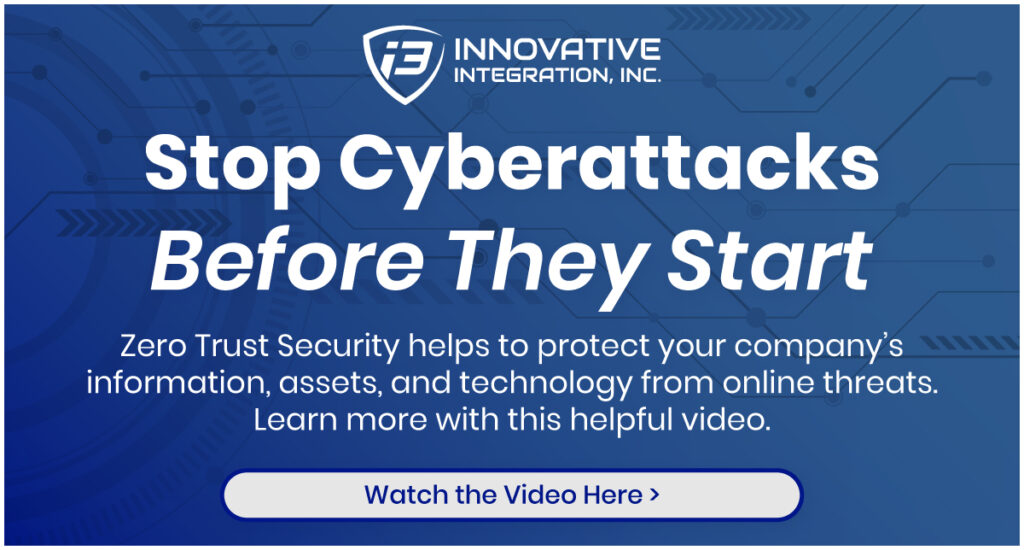Within the cybersecurity sector, there are many terms to know and understand that it is easy to be overwhelmed by all the terminology. One emerging model in cybersecurity is Zero Trust security. But what is Zero Trust security and why should you seriously consider it for your cybersecurity arsenal? Let’s discuss:
Cybercrime is on the Rise! Click Here to See Cybersecurity Stats.
What is Zero Trust Security?
Let’s start with some history because the Zero Trust model is actually nothing new. On the contrary, this model dates to 2010 when it was created by John Kindervag, a principal analyst at Forrester Research. These days, the Zero Trust model has enjoyed widespread adaptation from CIOs, CISOs, and other executives.
Zero Trust is a security framework which requires all users both inside and outside the organization to be authenticated, authorized, and validated before being granted and maintaining access to applications and data. In other words, the network, by default, trusts no one.
Zero Trust assumes that there is no traditional network edge—these networks can be local, cloud, or hybrid—with resources anywhere and workers in any location. This is a framework for securing infrastructure and data for modern digital transformation, addressing modern business challenges, including securing remote workers, hybrid cloud environments, and ransomware threats.
How Does Zero Trust Work?
The construction and execution of the Zero Trust framework combines technologies like risk-based multi-factor authentication, identity protection, next-generation endpoint security, and workload technology to verify a user and/or system identity while taking into consideration the access at the moment in time and the maintenance of system security. Other considerations Zero Trust requires are the encryption of data, secure email, and verifying the general hygiene of assets and endpoint before connecting to the applications.
Zero Trust is a distinct departure from the traditional network security, which abided by the now outdated “trust but verify” method. By default, the traditional approach would trust users and endpoints within the organization’s perimeter, putting the organization at risk from bad actors who may have stolen legitimate credentials, allowing unauthorized and compromised accounts wide-reaching access once they’re inside.
Why is the Zero Trust Model Beneficial?
Zero Trust enables organizations to reduce risk of their cloud and container deployments while also improving governance and compliance. Organizations can gain insight into users and devices while also identifying business processes, data flows, users, data, and associated risks. The Zero Trust model helps set policies which can be automatically updated based on any associated risks.
Organizations which shift from traditional perimeter security to the Zero Trust model increase their level of continuous verification capable of detecting the following methods faster and even stopping them before intrusion occurs:
- Phishing emails targeting employees
- Lateral movement through the corporate network
- Stolen developer password
- Stolen application database credentials

The principle behind Zero Trust Security is that no person nor device should be trusted.
Zero Trust capabilities can also be designed into business processes, services, and systems that are better enabled to:
- Prevent data breaches and limit lateral movement
- Easily expand security protection across multiple computing environments
- Gain visibility into users, devices, components, and workloads across the environment
- Continuously monitor and respond to signs of compromise
- Ensure organizational security while still providing a consistent user experience
- Reduce full-time equivalent hours and architectural complexity
As we can see, the Zero Trust approach to cybersecurity is the modern solution to modern security issues. Gone are the days of trusting the people and devices that connect to your company’s network and only asking for one credential—cybercriminals and their methods have evolved beyond that, and so our network security methods must, as well, and the Zero Trust model is this evolution. In the end, while we advocate the Zero Trust model for your cybersecurity solutions, you can trust the team at Innovative Integration to secure your network and keep your precious data safe.





